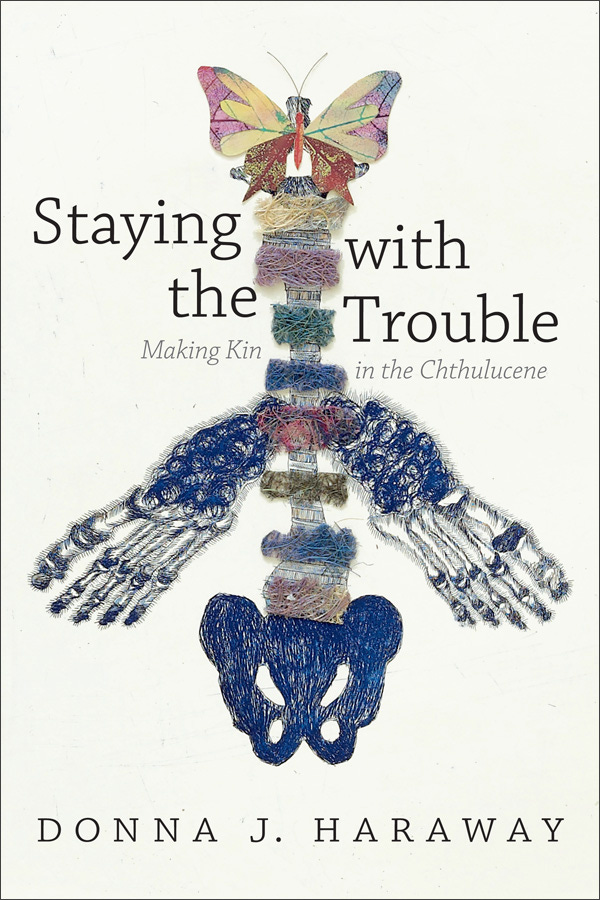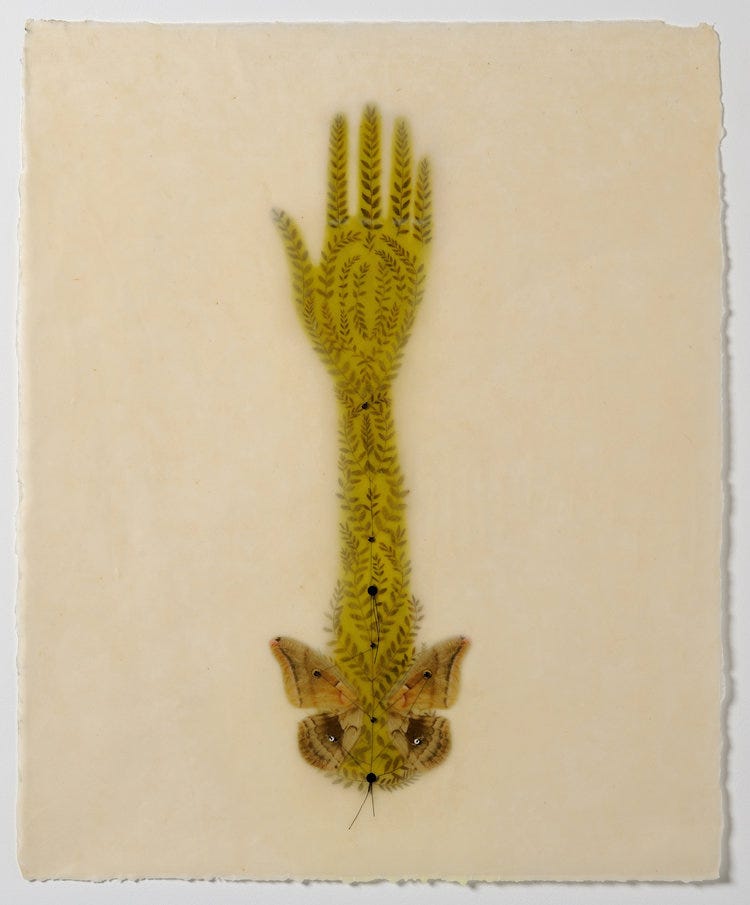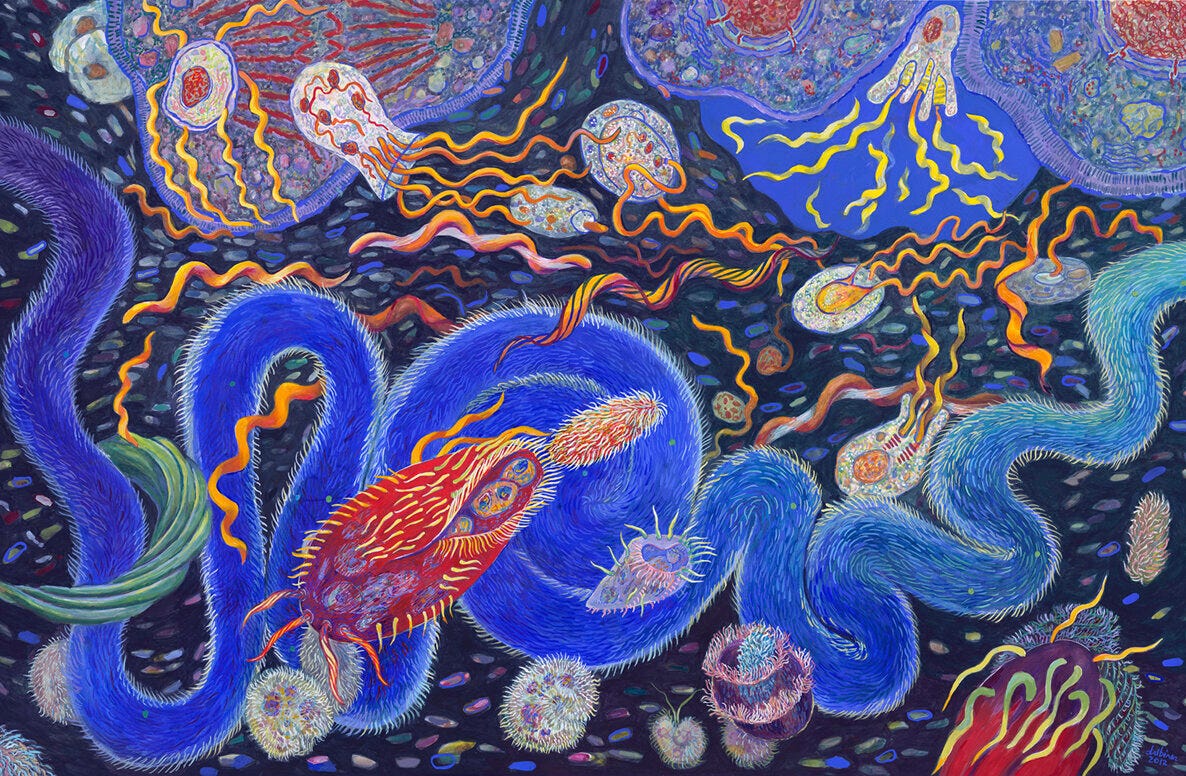Sympoiesis, Codename: Entanglement
Wrestling with Donna Haraway's theory of "making-with" in an effort to understand the kind of mark we're making on the world.
I’m taking a class this semester called “Ecologies of the Early Modern Book,” in which we talk about… well, everything.
We started with posthumanism, accidentally shifted into affect theory for a little bit, covered bibliophagia, and we’re planning on spending the whole of the semester discussing the way all of that intersects with Early Modern literature and our consumption of it (literally and otherwise—it’s weird!). We talk about the materiality of books, the ephemerality of ideas, and the contact zones between those, us, and everything, really.
It’s a very cool class, but it’s dense, and the theory that we’re reading is even more dense, so I wanted to use this week’s post to think things out and see if anyone could help me figure this out.
Fair warning: the content is feisty, and the vocabulary gets insane.

In her book Staying with the Trouble: Making Kin in the Chthulucene, environmental philosopher and scholar Donna Haraway gives us a lot of terms. Of specific interest to this mini-essay, I want to investigate Sympoiesis and The Chthulucene (side note: Haraway loves making up words, and I think it’s specifically to point out how normalizing and totalizing a lot of sociopolitical and scientific language is, especially when talking about the environment. I’ll get into this later when I talk about the Chthulucene).
Sympoiesis
The word “sympoiesis” was originally coined in 1998 by M. Beth L. Dempster in her Master’s thesis, A Self-Organizing Systems Perspective on Planning for Sustainability. In her thesis, she defines sympoiesis as a process of “collective production.” The word comes from the Ancient Greek sún meaning “together,” and poíēsis, meaning “creation, production.” Systems that utilize sympoiesis, or sympoietic systems, are “collectively producing, boundaryless systems.”
Haraway uses Dempster’s term and breaks down its Greek words, which literally mean “making-with.” She takes it further by implying that every system is a sympoietic system. She explains that the word and its implications should signal to us the inherent interactivity of everything in nature:
Nothing makes itself; nothing is really autopoietic or self-organizing… Sympoiesis is a word proper to complex, dynamic, responsive, situated, historical systems. It is a word for worlding-with, in company. Sympoiesis enfolds autopoieses and generatively unfurls and extends it.
(Haraway, 58)
I feel the need to take a quick vocab break here because even I was lost, and I did the prerequisite reading for this.
Autopoiesis means “self-making.” Systems that are closed off and completely independent of everything around them. Sympoiesis, “making with,” is the opposite of autopoiesis. Symbiogenesis (literally: together + life + creation/birth) is making life out of that interactivity and togetherness.
So walk with me. This seems like a lot of highfalutin language, but what she’s saying is that no individual body can exist solely within its own systemic function, nor does it create its role in a larger system alone. Humans are made up of different systems—nervous, digestive, sensory—and those systems are made up of small living things—microorganisms, cells, etc.—and so our bodies and our existence cannot be without other living things; therefore, we do not function individually.
On top of that, so much of what we interact with is or was a living thing. The wood of my desk was once a tree, which was once a seed, which was once an acorn, which was once part of a flower, which is part of a tree, and so on for eternity.
The point that I’m getting at is that everything is made up and a part of systems, and these systems might also be called “assemblages.” An assemblage is any grouping of things, which is not at all vague or broad (said with the utmost sarcasm because this field is itself very vague and very broad).
Here’s some help: look at the collection of writing utensils in your pencil cup on your desk as an assemblage. The pens and markers are separate, their ink cartridges are contained within them, the plastic casing is on the outside, the plastic or engraved label, and the material that is used to make the letters on the label—all of this makes up the utensils themselves. But together, they make up a handful of tools for art and annotation, right? They make up the pencil cup on the desk, which makes up your working space, which makes up your creative environment, and so forth forever and ever. We are surrounded by assemblages because everything is part of something.
Which means that everything is entangled.

While we, as humans, tend to prioritize human life (and often certain human lives) over everything else in the existential hierarchy, posthumanists and new materialists would want us to look around and say, “Wait a minute. What if all of it is important, and all of it matters?”
This is something called decentering humanity. It’s an effort to give a sense of agency and nuance to non-human entities. Now, I’m going to get very meta here and emphasize that this is a very human idea, and that humans talk to other humans about that which is and is not human, but I think that theory is for thought experiments and I want to think about what it means to be an assemblage made up of assemblages existing within an assemblage. I want to try and understand what it looks like from my very human eyes when I take part in symbiogenesis and make my life out of my interactions with all the other critters in the world.
This is what brings us to the Chthulucene.
The Chthulucene
Now that we’re thinking about decentering the human and understanding that everything is made up of everything, and all of that everything makes life, we should start asking questions: How should we continue? How should we make-with the world around us? How do we gain meaning and understanding from the parts of the world that aren’t human? How do we reconsider our impact on the environment and all the other beings within it when we understand that we are part of them and they are part of us?
So the term “Chthulucene” might spark some interest in anyone with a background in horror or weird fiction. While it’s reminiscent of H.P. Lovecraft’s cosmic entity, it doesn’t seem to be what Haraway is getting at.
According to the cultural and literary scholar Julia Grillmayr, Haraway's Chthulu is not directly named after H.P. Lovecraft’s horror creature, but after a Californian spider, Pimoa cthulhu. Analogous to Lovecraft's creatures, the spider carries in its name a reference to the chthonic. Chthonic are earth goddesses or forces of the Earth worshipped by animistic and pantheistic faiths. Haraway writes that she is adjusting “taxonomic spelling”, from cthulhu to chthulu, creating “a name for an otherwise, for an otherwise that was, still is, and might be”: the Chthulucene.
(from Dr. Elli Mosayebi’s “Twelve Theses” thesaurus)

Okay, so that’s great and all, Haylee, but what does it mean? Well, the Chthulucene is Haraway’s critique of the term Anthropocene, which is used to describe Earth’s current era, in which human activities have had a consequential impact on the planet. For Haraway, the phrase doesn’t offer the right vibe for the eco-critical precedent that she’s establishing. She wants us to break out of patterns and practices that are destructive to the Earth and its inhabitants (including us), but “Anthropocene” only emphasizes humans at the top of the existential hierarchy and emphasizes our individualism and self-invented exceptionalism. As the anthropos in this -cene, we are not the entire scene, we are just playing a role, and understanding how we are “making-with” and “becoming-with” every other role is how we come to grasp that.
According to Haraway, the necessary third history alongside the Anthropocene and the Capitalocene, “as a third tote bag in which to collect what will be crucial to whether it goes on at all, decide to stay restless… Unlike the Anthropocene and the Capitalocene, the Chthulucene is composed of continuation histories and cross-species practices of becoming with one another” (80). In the epoch of the Chthulucene, humans and non-humans are inextricably linked, entangled in one another.
It is not so much a proof-in-pudding concept as it is a way of thought that she’s pushing in her book. To make-with every living and nonliving thing on this earth, we must consider ourselves as being in an epoch of entanglement with, not estrangement from, the rest of those “critters.”
So What?
I think that the reason these ideas of sympoiesis and the Chthulucene interest me so much is because of the way Haraway casts it. It isn’t a “we need to return to nature, throw ourselves into the pastoral, learn to milk cows and reap our own wheat” sentiment—she wants us to learn how to live with the earth as we have shaped it and learn to cohabitate with the critters running around on it.
Instead of assuming that we are in an epoch of human destruction that can only be “fixed” by idealizing and fantasizing about nature and what it should/might be like, we ought to buckle down and accept that everything contributes to everything because it all came from everything.
And at the end of the day, it will all return to everything.
Haraway especially interests me from her position because she states that she is not a posthumanist—she is a compostist. A new term that I think we’re all unfamiliar with, but that I think might resonate regardless. She says:
I am a compostist, not a posthumanist. Critters—human and not—become-with each other, compose and decompose each other, in every scale and register of time and stuff in sympoietic tangling, in ecological evolutionary developmental earthly worlding and unworlding.
(Haraway 97)
We are part of the system that comes to life and dies all the same. We use pencils that are made of murdered trees, and we create literature and theory about tree-sentience with them. We put the plastic in the ocean that suffocates the sea turtles, and we feel the loss of those critters at an ever-growing scale. We kill the spiders that eat the bugs that eat our food and make the fruit flies fly faster. We breathe out what nature breathes in, and it breathes out what we breathe in.
We are entangled. We are becoming-with in the Chthulucene.
TLDR: Big vocabulary or not, I think that we all understand the ongoing impact we have on the world and the impact that it has on us. We understand that critters and creatures who determine and are determined by us. We are intrinsically entangled with all that exists because we also exist. So I think that we can all take something from Haraway and her emphasis on the other-than-human and the idea of moving towards a Chthulucene.






A fantastic read, Haylee!!
I especially loved this line, “she wants us to learn how to live with the earth as we have shaped it and learn to cohabitate with the critters running around on it.”
Co-existence is the way of life!!
I learnt all these new terms and concepts and you’ve elucidated them in a succinct way.
Great job 👏